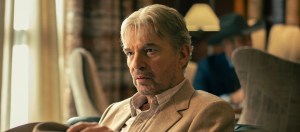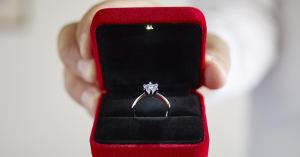Casual fans may or may not be surprised to hear that the Game of Thrones fandom has not died down since the series finale back in May. On the contrary, die-hard followers have been hard at work digging through the series, looking for early Easter eggs that foreshadowed the ending. Months later, some of their findings are impressive.
Warning! Spoilers for Game of Thrones and A Song of Ice and Fire are ahead!
Videos by PopCulture.com
There is no denying that Game of Thrones had a divisive ending, leaving many viewers disappointed. However, not all hope for Westeros is lost. Author George R. R. Martin is still hard at work on the final two books in his series, which will be far longer, more developed and in some cases, completely different than the show.
For fans of the book series, A Song of Ice and Fire, the final seasons of the show now serve as a kind of outline for the upcoming volumes. They know that showrunners David Benioff and D.B. Weiss got the broad strokes of their ending from Martin himself, so it is just a matter of picking out what will appear in the books, and how it might be different.
Based on interviews with Martin, Benioff, Weiss and others involved in production, fans have a pretty good idea of what will be the same in the books. Major plot elements will be the same — Bran Stark will likely wind up as king, Daenerys will likely be killed, Jon Snow will likely be exiled to the north, and so on. However, where the show took a straight path to get there, the books will meander, leaving more room for magic, politics and war.
Fan theorists everywhere are now using these end points to reverse-engineer the story, filling in the gaps for what comes in between. Many are looking back at the first five books and are surprised to find plenty of foreshadowing of Bran on the throne or Daenerys losing control.
Here is a look at how A Song of Ice and Fire has foreshadowed the same ending we saw on Game of Thrones.
Opening Scene

To make sense of the ending, many fans went back to the very beginning, and in this case it may be the right strategy. The beginning of A Game of Thrones is read by many fans as a symbolic foreshadowing of the ending writ large.
The book begins much like the show — with a prologue introducing the White Walkers, or The Others, and then with Bran. It is worth noting that, by giving Bran the first real chapter in the book, Martin goes a long way in setting him up as the hero from the beginning. If that weren’t enough, the scene follows Bran learning to rule from his father, as he beheads a traitor to the Night’s Watch.
One popular idea among fan theorists is to read the prologue as an inverted microcosm of the story itself. Redditor Joe Magician makes the case that the ranger who fights the Others here, Waymar Royce, is a stand-in for Jon Snow. The Others “test” Waymar, in a way, to see if he is the hero they’ve been waiting for. When he is not, the assimilate him.
In the ominous end of the prologue, Waymar even resembles Jon a little. He ends up with only one eye open, much like Jon after an eagle scars his face. He also has “nerveless fingers,” similar to Jon after he burns his hand saving Lord Commander Mormont.
This supports the popular idea that, in the books, Jon will indeed end up banished north of The Wall. However, book-readers suspect that Jon’s resurrection will look much different in the text. He may be more similar to a wight, possibly like Beric Dondarrion. If that is the case, Jon may be banished magically, not politically.
Azor Ahai
Of course, fans have long been obsessed with the myths and prophecies in ASOIAF, particularly the story of the ancient hero Azor Ahai. The hero is said to have tempered his magic sword in the blood of his wife by impaling her on it, giving him the power to save the world.
Fans have interpreted this to represent just about every combination of characters over the course of the series. In the end, the closest parallel seemed to be Jon Snow and Daenerys, when Jon stabbed Dany in the throne room. It seems clear that some version of this scene will take place in the books as well, but we can expect it to play out a little differently.
Assuming Jon and Daenerys do have a romantic relationship, however, it looks like we have our Azor Ahai and Nyssa Nyssa.
Daenerys’ Daydream
(Spoilers main) “Dany had no wish to reduce King’s Landing to a blackened ruin of unquieted ghosts.” from r/asoiaf
One of the toughest endings to find foreshadowing for is Dany’s. For the whole series, Daenerys has been a sympathetic, heroic character, and fans want to see her succeed. Obviously, Martin thought hard about turning her into a tyrant, and while the show’s execution was lacking, it could make for a compelling turn in the next two books.
Rather than looking back for signs that Daenerys was cruel or unhinged in the past, many fans are simply looking at signs that destruction is inevitable as long as dragons rule. Even Daenerys seems to understand this, looking back on the history of her family. In A Clash of Kings, in Daenerys’ second chapter, she reflects on how she wants to be a different kind of monarch, even as she considers bringing her Dothraki army to Westeros.
“The thought of home disquieted her. If her sun-and-stars had lived, he would have led his khalasar across the poison water and swept away her enemies, but his strength had left the world. Her bloodriders remained, sworn to her for life and skilled in slaughter, but only in the ways of the horselords. The Dothraki sacked cities and plundered kingdoms, they did not rule them. Dany had no wish to reduce King’s Landing to a blackened ruin full of unquiet ghosts. She had supped enough on tears. I want to make my kingdom beautiful, to fill it with fat men and pretty maids and laughing children. I want my people to smile when they see me ride by, the way Viserys said they smiled for my father. But before she could do that, she must conquer.”
Obviously, Daenerys does not want to destroy King’s Landing, as fans have been complaining since the show’s finale. However, it seems the point Martin is trying to make is that a dragon cannot control what it burns once the fire starts. Hopefully, this point will be more clear in the books.
Tyrion’s Help

Turning to Bran’s ending as the ultimate king, there is one neat piece of foreshadowing to consider. In A Game of Thrones, Tyrion stops at Winterfell on his way back from The Wall. There, he gives Maester Llewyn a design for a special saddle that will allow Bran to ride a horse, much like the one he uses.
“I have a tender spot in my heart for cripples, bastards and broken things,” he says.
Here, Tyrion literally helps Bran up onto a higher seat, as he will eventually help him up onto the throne, if the show is right. In addition, he coins the nickname that he eventually uses in the Great Council: Bran the Broken.
Ygritte
For Jon Snow, romance has never been easy. As hard as it was to watch him turn on Daenerys in the end, it was not without precedent. Fans of the show and the book alike probably remember how things went when he had to choose between his Night’s Watch vow and his wildling love, Ygritte.
Jon did his best to sneak away without harming Ygritte, but she did not take kindly to that. She wounded him with an arrow as he rode away, and then fought against him at Castle Black shortly after. Jon was conflicted in the battle, but he still fought against Ygritte to honor his oath. Eventually, we will watch him do the same against Daenerys if she threatens the realm.
‘Not Dead, Just Broken’
Another popular quote going around online these days foretells Bran’s final fate. The line comes from A Clash of Kings, just as Bran is leaving the ruins of Winterfell with Hodor and the Reeds. The young prince looks back on the only home he has ever known and reflects that it is very similar to him.
“At the edge of the wolfswood, Bran turned in his basket for one last glimpse of the castle that had been his life. Wisps of smoke still rose into the grey sky, but no more than might have risen from Winterfell’s chimneys on a cold autumn afternoon. Soot stains marked some of the arrow loops, and here and there a crack or a missing merlon could be seen in the curtain wall, but it seemed little enough from this distance. Beyond, the tops of the keeps and towers still stood as they had for hundreds of years, and it was hard to tell that the castle had been sacked and burned at all. The stone is strong, Bran told himself, the roots of the trees go deep, and under the ground the Kings of Winter sit their thrones. So long as those remained, Winterfell remained. It was not dead, just broken. Like me, he thought. I’m not dead either.”
The imagery of “roots” going “deep” is particularly interesting here, as roots do not have anything to do with castles. They do, however, have to do with Bran’s fate, as he will soon learn the secrets of the Wierwood trees and join the hive-mind of the Greenseers.
The Black Goat of Qohor
Show-only fans may be sick of hearing it from book-readers, but the fact remains: there are a ton of characters and storylines that were tragically left out of the screen adaptation. At the time where the last book left off, Westeros would be unrecognizable to a show-only fan, with all the added plots in action.
One aspect of this is the political intrigue of Essos, where the world is responding to the rise of Daenerys. The followers of R’hllor — the religion espoused by Melisandre — are rising up in support of Daenerys, and in some cases, meeting resistance. As Reddit user The Coconut God pointed out, there is an expertly told side-story about this in the city of Qohor.
Qohor is a creepy, insular city with lots of rumors of “dark magic.” Its local religion is the worship of The Black Goat, a god that demands daily blood sacrifice and pennance. In A Feast For Crows, Arianne Martell learns that the followers of R’hllor within Qohor have risen up in Daenerys’ support and burned The Black Goat.
This is a throwaway line in the text, yet it is shocking in the context of the larger world. Worship of The Black Goat is at least several hundred years old, and likely older. The Black Goat may be symbolic of what happens to old institutions that try to stand up against dragonfire.
Later, in one of Tyrion’s chapters in A Dance with Dragons, Tyion learns about the widespread rioting as well. He thinks that it must be futile to stand up against Daenerys. It is then that he and his sellswords are served food.
“Supper was a plate of roasted goat served on a bed of sliced onions,” one passage reads. “The meat was spiced and fragrant, charred outside and red and juicy within.”
Whether Daenerys believably “goes mad” or turns into a tyrant, it is clear that her role in the world was always linked to bloodshed. It should be no surprise, then, that she brings another massive loss of life with her to Westeros.
Children of The Forest
Finally, let’s take a tiny peek at one of the most interesting areas of foreshadowing for Bran: the Children of The Forest. This ancient race ran Westeros before mankind got there, and is believed to have given the First Men magic like Bran’s greenseeing abilities.
In Martin’s reference book The World of Ice and Fire, we learn that the Children followed their Greenseers as leaders. We also learn that humans sometimes became “Greenseer kings,” or “Warg Kings” once they gained the same powers. Many fan theorists, including YouTuber LmL, suggest that Bran will look more like a Greenseer king when he takes the throne than the human kings we are used to.
In this context, a lot of things fall into place. With the Iron Throne gone, Bran can rule from a Weirwood throne, like the tree roots growing around and into his mentor, the Three-Eyed Crow.
In fact, some think that Bran will not rule from King’s Landing at all, but from The God’s Eye, a mysterious location never visited in the show. In the books, The God’s Eye sits at the center of the great lake where Harrenhal is built. The island is supposedly home to the Green Men, a mysterious race somehow related to the magic of the old gods, and perhaps the Children.
In the books, Meera and Jojen’s father Howland traveled to the God’s Eye and studies with the Green Men, before leaving to attend the Tourney at Harrenhal. It seems plausible that Bran will end up there as well, ruling Westeros from the ancient seat of other semi-immortal beings.
There is a lot to get into here, and many variations on the ideas behind this theory. The important thing to consider, however, is the commentary Martin is making. A staunch pacifist, his series seems to say that there is no political justification for the bloodshed of war, even for a hero like Daenerys. He also seems to be anti-authority in general, suggesting that the only “fit” ruler is a mystical king with the knowledge of a hive-mind, the innocence of a child and the nobility of Ned Stark.
Of course, we will not know for sure until we see the text itself. Martin is hard at work on The Winds of Winter, and then promises to complete A Song of Ice and Fire with the last book, A Dream of Spring. Meanwhile, HBO has two spinoff series in production exploring other parts of Westerosi history. Check back for updates and coverage of all things Westeros on PopCulture.com.








